Menus
- More casual off-road version of the CB
- 90,000 CL 77s were sold in the USA
- With a new ultra-short stroke
- More street bike than scrambler

bilski-fotografie.de
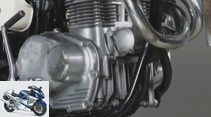
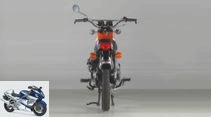
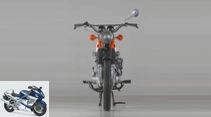
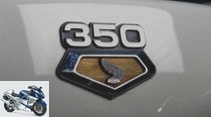
13 photos
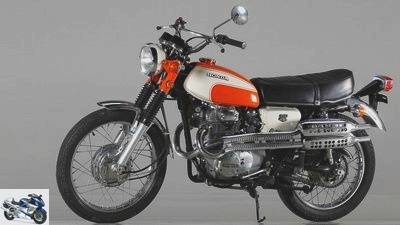
bilski-fotografie.de
1/13
Honda’s two-cylinder CL 350 scrambler was a huge success. At least in the US.
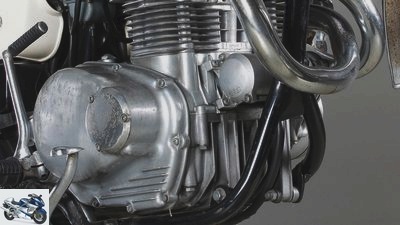
bilski-fotografie.de
2/13
The CB and CL use the same frame, which leaves enough space in front for the electric starter placed in front of the crankcase.
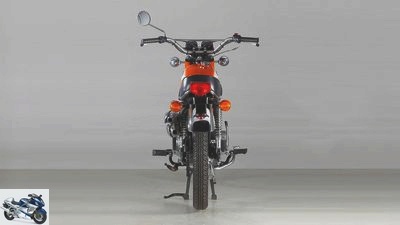
bilski-fotografie.de
3/13
Main stand, permanently installed indicators – that’s probably more street bikes and not enduros.
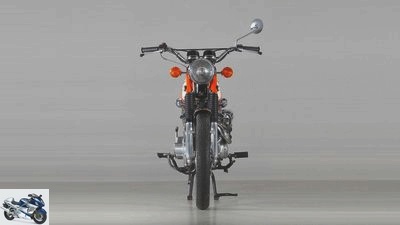
bilski-fotografie.de
4/13
The German insurance companies made this engine size unaffordable compared to 250 engines. That’s why Honda didn’t even offer the Scrambler in Germany.

bilski-fotografie.de
5/13
An unfavorable cubic capacity in Germany, extremely popular in the USA.
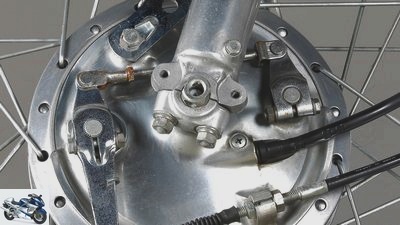
bilski-fotografie.de
6/13
Unlike the CB, the CL retained its front duplex brake until the end.

bilski-fotografie.de
7/13
Bellows were part of the CL, as was the color paint for the fork tubes.
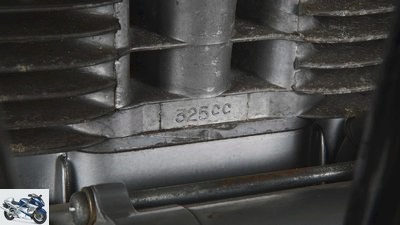
bilski-fotografie.de
8/13
The truth is written on the casing, which is very small: this twin is not a 350 at all.
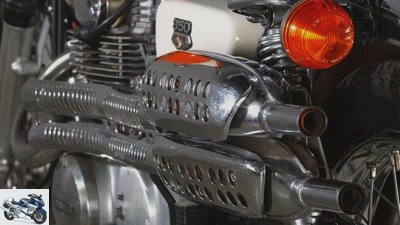
bilski-fotografie.de
9/13
Loud is out, said the US authorities, and that’s why it’s wearing
the CL two small silencers.
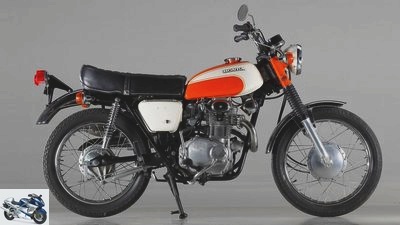
bilski-fotografie.de
10/13
The color scheme and the instruments inclined towards the driver prove that this CL was built in 1973.
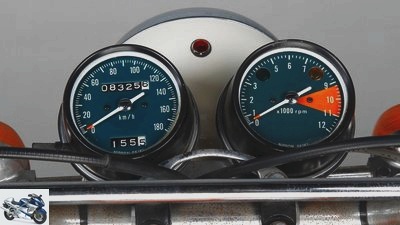
bilski-fotografie.de
11/13
The red area begins just at the rated speed; the CL 350 really develops fire from 6000 rpm.

bilski-fotografie.de
12/13
A tidy and solidly produced construction: Honda has been setting quality standards since the late 1960s.
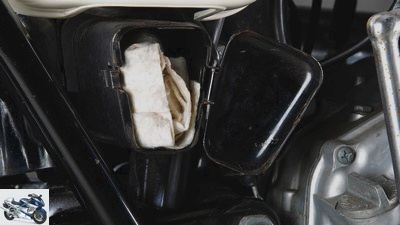
bilski-fotografie.de
13/13
Tools for changing a candle fit in here, but never for a puncture off-road.
Classic presentation of the Honda CL 350
More casual off-road version of the CB
Content of
Honda’s two-cylinder scramblers were a huge hit in the US, and the Honda CL 350, launched in 1968, won the most. It was hardly more suitable for the terrain than its sister CB. Just somehow more casual. Or?
M.an occasionally wonders whether globalization tends to make everything the same. Hollywood films everywhere, Asian clothes everywhere, Google and German SUVs everywhere. Stories like this would then be impossible. The fact that 250cc is booming in one market because strange insurance regulations make motorcycles of this displacement just affordable, while elsewhere you naturally go for the sovereign, equally inexpensive and technically identical 350cc. Or that on one side of the Atlantic everyone pretends to win desert races every day, while on the other they chase after that Grand Prix feeling with retrofitted M handlebars.
At least in the 60s it was like this: While Honda in Germany didn’t even get the idea of offering Scramblers and their street 250s were selling like sliced bread, the Americans just as often chose the clunkier version of the popular Honda Twins and, if possible, those with them the larger displacement.
90,000 CL 77s were sold in the USA
The desert races, which are as popular as they are spectacular, had already seduced some English people into adventurously adorning one or the other twin with small tanks, larger front wheels, wide handlebars and – very importantly – raised exhausts. The BSA Spitfire can be regarded as particularly successful and also commercially successful, and Soichiro Honda set his CL 72 on its tracks in 1962, the derivative of the epoch-making 250 CB 72. When it got a big sister with exactly 305 cm³ displacement, namely the CB 77 , there was also a CL variant of it from 1965. Both sold quite well, with a total of nearly 90,000 North Americans grabbed it.
Then everything became new. At least on the engine side. The successors introduced in 1968 also had a built crankshaft cranked by 180 degrees and a drive chain running between the cylinders to the overhead camshaft. But the aluminum cylinders are no longer inclined forward, the camshaft rotates directly in the bearing blocks of the cylinder head, the mixture is now prepared by modern constant-pressure carburettors, and the gearbox controlled by a gear primary drive has five instead of four gear stages. The 250 got a little more bore (56 instead of 54 mm) and correspondingly less stroke (50.6 instead of 54 mm), with its big sister 64 mm bore at the end for 325 cm³ – the old CB / CL 77 only had 305 brought.
With a new ultra-short stroke
As usual, Honda brought a road and an off-road version of the new Twin, both of which can be started either electrically or by kick. Wait, will CL connoisseurs object, electric? In fact, on the CL 72 and 77, due to the front frame strut prescribed for them, there was no longer any space for the starter located in front of the crankcase. It fell away, a plain sheet of metal covered the opening in the case, but the off-roaders got a slightly longer kick starter. From then on, such unfriendliness was no longer necessary, because Honda now consistently relied on a closed frame with pressed sheet metal backbone plus tubular beams for both CB and CL and built this right around the electric starter.
The differences between the two versions lie in the details: The Honda CB 350 has an 18-inch wheel rotating at the front, the Honda CL 350 measures 19. The handlebars and tank obviously vary, especially the wonderful exhaust system. As with the BSA Spitfire, the manifolds cross in front of the cylinder and then strive backwards in parallel. In contrast to the BSA and the early CL 72/77, however, small silencers had to be integrated. Who knows whether they will ultimately ensure that a CL350 engine with 33 hp delivers three hp less than the otherwise identical CB drive. After all, it produces maximum power and maximum torque at slightly lower speeds, and besides, it is still enough for 100 miles per hour. That counts. And was possibly more important than any off-road talent in the purchase decision.
More street bike than scrambler
These may have been a bit larger than the CB, because the ground clearance had actually increased thanks to the 19-inch front wheel and high-set exhaust system. But a well-dimensioned double seat bench and pillion footrests attached to the frame as well as a complete set of instruments and main stand indicate rather low ambitions. And so the colleagues of the US magazine “Cycle” found on their first excursion in 1968: “The scrambler isn’t really a scrambler at all.” They advocated classification as a street scrambler and by that I mean, the The Honda CL 350 might have little harm on wavy dirt roads, but it is rather unsuitable for stick and stone. And too heavy on top of that.
Perhaps Honda saw things similarly, because as early as 1969, with the SL 350, which was around 15 kilograms lighter – it was the top model of an entire off-road family – a real specialist came into the spotlight, with a double loop frame, longer suspension travel and ultimately even a 21-inch front wheel could take a lot. Really dual purpose. The Honda CL 350, on the other hand, gained its double benefit of being tame, absolutely suitable for everyday use and a cool look, not unlike today’s heavy large enduro bikes, and it brought US customers almost crazy for half a decade: between 1968 and 1973 around 215 000 units sold, plus a good 90,000 SL, both together a lot more than the CL 250 that was also on offer. Incidentally, the normal CB 350 came to 319,000?
Related articles
-
Presentation of the Honda VTR 1000
Presentation, Honda VTR 1000 F Firestorm Honda VTR 1000 Italy’s sport twins were the sole rulers. Forza Italia. Now the world power Honda is striking back, …
-
Comparison test Honda VT 750 C2-Kawasaki VN 800 Classic
Comparison test Honda VT 750 C2 / Kawasaki VN 800 Classic Endstation Sehnsucht Or how you can get your kicks in Stuttgart-Bad Cannstatt …
-
fact 17th photos fact 1/17 Honda CR 450 Classic Racer. fact 2/17 Honda CR 450 Classic Racer. fact 3/17 Less for the racetrack, more for the eye: the CR…
-
Presentation of the Honda RC213V-S
Honda 10 pictures Honda 1/10 The term road racing takes on a whole new meaning: With the RC213V-S, Honda is building a flawless MotoGP offshoot …
-
Presentation: The Honda CB Seven Fifty conversion from Louis
Louis 21 pictures Louis 1/21 Master Guido welds what the burner has to offer. Louis 2/21 main stands are something for chain care wimps. Louis 3/21 …
-
Innovations: Presentation of the Honda Fury
Honda novelties: Presentation of the Honda Fury Puristic Japanese chopper The Honda Fury not only impresses with its successful shapes and proportions, it shines …
-
Honda CBR 1000 F Type SC 21 Ride with the classic
12th photos Stefan Wolf 1/12 The 1980s Honda CBR 1000 F is the ultimate yogurt cup. We took a trip with the classic. Stefan Wolf 2/12 The mudguard also…
-
Impression Honda CB 750 Four Fit for Four Some men believe that they have to plant trees, father sons or kick certain single-cylinders in order to…
-
Cruiser comparison test: Honda VTX 1300 S, Kawasaki VN 1600 Classic
Cruiser comparison test: Honda VTX 1300 S, Kawasaki VN 1600 Classic Damn long hard Handy six-centimeter chunks, wheelbases begging in the parking bay,…
-
On the move with the Honda MVX 250 F.
Wolf 29 pictures Wolf 1/29 The MVX was not a big seller, but the speedster with the V3 engine is still a lot of fun. Wolf 2/29 Wolf 3/29 Wolf …